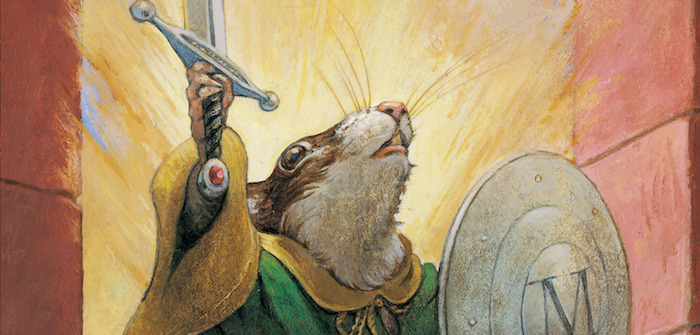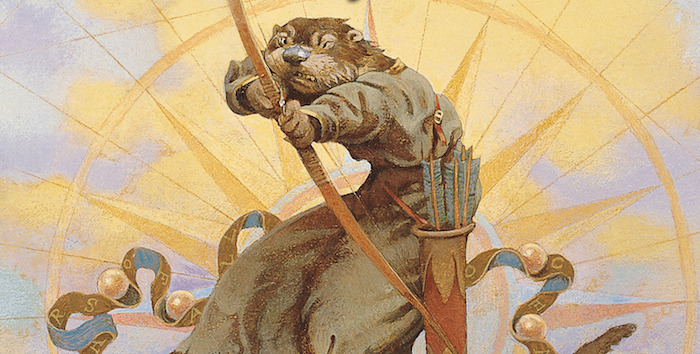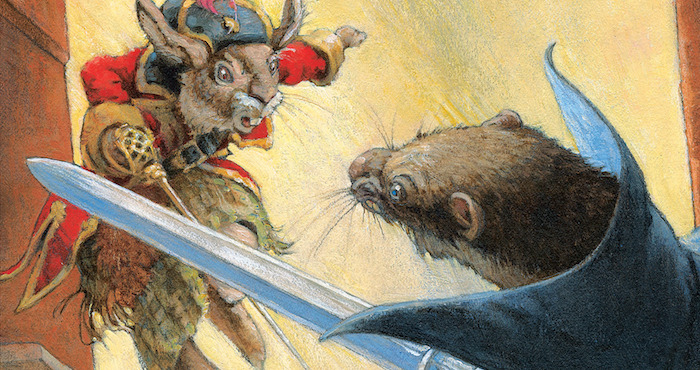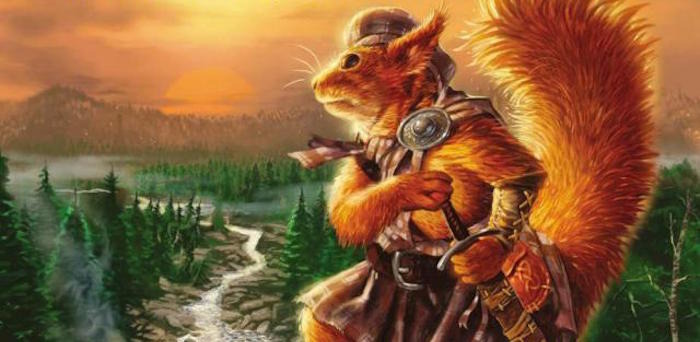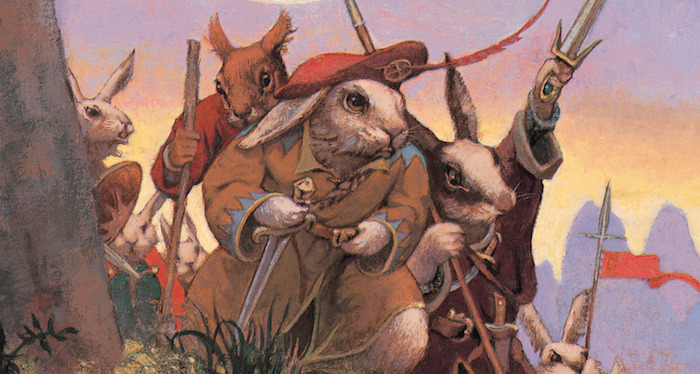Why 'Redwall' Should Be The Next Huge Movie Series
In an ideal world, Hollywood would focus entirely on wholly original films, from low-budget dramas to big-budget action/adventure/science-fiction stories. When the industry does go back to original storytelling, it can often yield major successes; we're only a couple months removed from the low-budget original horror smash Get Out, released by Universal Pictures.
But hoping only gets you so far. Even the briefest look at the summer-movie calendar in 2017 and beyond offers sequels, prequels, remakes, reboots, revivals, and everything in between. Some of those movies, no doubt, will be a lot of fun, but that doesn't mean that something new in the world of movie universes isn't needed.
So, in the spirit of "If you can't beat 'em, join 'em," here's a humble suggestion to the industry: if you want to find the next great franchise, you just need to adapt the Redwall book series. This is an all-but-guaranteed moneymaker that (mercifully) would also be a wonderful adaptation. Why? Let's explain.
What is the Redwall series?
First, for the uninitiated, Redwall is a 22-book series written by the late British author Brian Jacques, published between 1986 and 2011. (The last book in the series was published posthumously, mere months after Jacques' passing.) The books were aimed at 8- to 12-year olds, and depicted the adventures of a series of woodland animals in the forests of the United Kingdom. Some of the animals – typically mice, squirrels, moles, otters, shrews, hares, and badgers – are pure of heart, heroic, courageous, and generally good guys. Others – typically rats, stoats, weasels, foxes, and ferrets – are vain, selfish, vicious, and cruel. Within each book, there's a new struggle between good and evil; the first published book, fittingly titled Redwall, is about how the denizens of the eponymous abbey fend off a group of piratic miscreants led by a nasty rat named Cluny the Scourge. Other books in the series allowed Jacques to expand the world first envisioned in Redwall, introducing readers to the rest of Mossflower Woods, where Redwall Abbey is located, from the badger-ruled mountain of Salamandastron to its surrounding islands.
The short answer is that the Redwall series offers a massive universe waiting to be designed, memorable characters who could become as well-known and beloved as those from franchises like Harry Potter and The Lord of the Rings, an opportunity for jaw-dropping photorealism in animation, and a mythology that doubles back and forth in ways that echo how comic-book movie universes are designed. Just over 30 years after the release of the first book in the series, the question shouldn't quite be "Is Redwall worth turning into a series of films?" Instead, the question should be "Why hasn't Redwall been turned into a series of films yet?"
Redwall and Its Long, Complicated Mythology
Let's start with the last point from that paragraph: the back-and-forth mythology of the Redwall series, specifically embedded within its chronology. For whatever reason, Jacques didn't tell the stories of the Redwall universe in chronological order, at least for the first 13 of 22 books. After Redwall, Jacques wrote a prequel titled Mossflower; that was followed by a direct sequel to Redwall called Mattimeo, which was followed by Mariel of Redwall. That book took place after Mossflower, but not directly after, nor directly before Redwall. (And so it would go for the next nine books.) This back-and-forth publishing style imbues each story with new life, even as critics would suggest that the series repeated a similar formula. Here, at least, that back-and-forth style would be ideal for a film franchise, specifically in building up the sense of a tantalizing puzzle waiting to be fully pieced together.
There are few things that franchises of any stripe – from the Marvel Cinematic Universe down to the recent Power Rangers – love more than having some kind of mythology cooked into the storytelling. It's one thing to have a group of heroes banding together; it's another to have the distinct sense that there is larger, overarching story being told in which they play a growing role. In utilizing a chronology that doesn't line up with the publication history of the books, Jacques established that the citizens of Redwall Abbey as depicted in the first book are just one piece of a larger, equally rousing puzzle that displays the history of Redwall.
Within the plot of Redwall, Jacques begins to build out that history through the journey of its lead character, a heroic young mouse named Matthias. Though the resourceful members of Redwall Abbey, as well as a group of tribal shrews and a garrulous hare, band together to fend off the attack from Cluny and his gang, Matthias gets something akin to the Joseph Campbell hero's-journey arc. He has humble beginnings, dreaming of the prospect of adventure outside the abbey walls, only to rise up when adventure comes knocking on his door. Specifically, he follows in the footsteps of the champion and original defender of Redwall who hovers over its past: Martin the Warrior.
Martin is another mouse (though Redwall is home to many anthropomorphized animals, mice often reign supreme), whose exploits are the stuff of legend within the first book. He appears there as a ghostly figure to inspire Matthias, as he does in future books with other champions of Redwall. But the original Redwall leaves the question of Martin the Warrior's past up in the air: what's the story behind the legend? The second book in the series, Mossflower, functions as an explanation of how Martin first arrived in Mossflower Woods from reaches beyond. Once in the forest, he helps take down a savage cat (natch) who rules the land with an iron paw. But Martin's actual origins are primarily saved for a later book, appropriately called Martin the Warrior. (An even later entry in the series, The Legend of Luke, partly tells the story of Martin's father and his youth.) The doubling back and forth in time highlights one of this series' many benefits in terms of turning it into a film franchise: there are mysteries to be explored throughout each entry.
Here's a good example from Mossflower of the kind of mythologizing that Hollywood loves, and of the mysteries inherent in the series: one of its supporting characters, a matronly badger named Bella of Brocktree, offhandedly mentions her missing son Sunflash to another character midway through the book. The brief epilogue of Mossflower reveals that Sunflash is alive and well, and has discovered Salamandastron, the aforementioned, fabled badger-led mountain where he will become its next leader. Jacques would eventually tell Sunflash's entire story in Outcast of Redwall, the eighth book published in the series. In between, there are no other teases or hints about Sunflash, just the fascinating possibility held out at the end of Mossflower. It's the equivalent of Nick Fury stepping out of the shadows to recruit Tony Stark into the Avengers.
This is all a lengthy way to emphasize that the Redwall series has its own history just begging to be brought to the big screen. The book-specific adventures are plenty exciting, but the sense that many of them are set-ups waiting to be paid off is even more thrilling. (Mattimeo, the sequel to Redwall, as another example, reveals that its main villain is an older version of one of the side baddies of the first book in disguise, seeking revenge.) In an industry that continues to adapt and expand as many intellectual properties as possible, and as many YA book series as possible, Redwall fits in perfectly; it delivers in spades with the mythology Hollywood wants fans to obsess and theorize over.
Bringing Redwall to Life Through Photorealism
The ideal company to turn the Redwall book series into movies would be Disney. For one, the notion of anthropomorphized animals is almost built into the company's history. More specifically, the illustrations by Gary Chalk of the books themselves suggest a fresh and colorful new world to bring to life via photorealistic animation. (Being fair, the animators at either Walt Disney Animation Studios or Pixar Animation Studios would have a veritable feast on their hands in bringing this verdant world to life.) As of late, Disney has been no stranger to relying on photorealistic computer animation in its films, such as for the production of Jon Favreau's The Jungle Book (as well as, presumably, his upcoming The Lion King remake). Pixar Animation Studios continues to push the envelope with its innovation in photorealism; though it remains their weakest financial performer, The Good Dinosaur has some of the most remarkable set design and background work of any animated film, suggesting genuine reality around the exaggerated designs of the dinosaurs themselves.
Though The Good Dinosaur was, at best, a compelling misstep for Pixar, its stylistic choices pose the right way forward for whatever studio pursues Redwall as a franchise. Photorealism can, and often does, extend beyond the design of the physical world the characters of a story occupy, into the characters themselves. The obvious example is last year's The Jungle Book, which eschewed the more deliberately cartoon-y character design of the 1967 animated feature; instead, characters like Baloo, Bagheera, and Shere Khan look like real brown bears, jaguars, and tigers, just with moving lips. While The Jungle Book was a huge creative and financial success for Disney, and The Good Dinosaur wasn't, leaning even harder into making the characters of a world as photorealistic as that world they embody might only serve to alienate and potentially trouble audiences. Even though the Redwall books don't depict British-set animal battles as grim as, say, Watership Down, there's bloodshed and loss of life on both sides in each entry in the series. (The Jungle Book has some action, but maybe not as much as a Redwall adaptation would.)
The world of Redwall and the Mossflower Woods, as well as the nearby mountains, forests, ocean, and more, could be brought to life in lush, detailed color. The possibility for genuine immersion is equivalent to the first time that Middle-Earth or Hogwarts was depicted on the big screen. But the characters themselves would be more expressive, not less, if they didn't look like literal mice and squirrels and rats and the like. (The image of a mouse wielding a sword is, perhaps, absurd enough to consider without the character looking like a literal rodent you might stumble by in the countryside.) Think of the way characters look in The Jungle Book and The Good Dinosaur as extreme opposites: hyper-real and hyper-fake. There is a happy middle, a way for the characters to look appropriate to a photorealistic world without themselves being photorealistic, akin to the way the animals in Zootopia are presented. As captivating as the stories are, the animation possibilities are tantalizing and nearly infinite.
A Series of Unforgettable Characters
Speaking of those characters, Jacques offered a plethora throughout the franchise. One criticism that's easy to make of the later books in the series is that the characters and their stories feel a bit formulaic. What was once fresh and exciting becomes familiar because certain characters have distinct traits in each book. It's not just that rats and weasels and foxes are, by and large, always the bad guys in a Redwall book, or that mice and badgers and squirrels are always the good guys. It's that specific animals always occupy the same traits within the spectrum of good or bad. This criticism holds water, but primarily for the last eight or nine books in the series (which, notably, are those that no longer jump around in chronology in the massive life span of the Mossflower Woods).
In the earlier books, there's a bounty of characters who are instantly easy to love, either because of how valorous or romantic they are or because of how odious they are. Matthias and Martin, early heroes of the series, are never bland or single-dimensionally defined solely by their heroism. (Martin, specifically, is one of the more complex characters in the series. When we return to his younger self in Martin the Warrior, pre-Mossflower, he falls in love with a female mouse who stands toe-to-toe with her level of fierceness; when she's tragically killed, he's unable to stay behind to inform her family of her passing.) At least among the heroic characters, Jacques did an excellent job of separating specific traits so that the animals feel distinct not just because some are badgers and some are mice. Hares are defined as both exceedingly outgoing and exceedingly fierce. From the first book onwards, starting with the puffed-up Basil Stag Hare, they function as comic relief that can also turn deadly quickly.
Of course, as memorable as the heroes can be – from Matthias to Sunflash the Mace to young mouse-maidens like Mariel Gullwhacker from Mariel of Redwall and Bryony from Outcast of Redwall – the villains are almost better. Cluny the Scourge in the first book establishes the basic template for the baddies in these books: physically imposing, nefarious, selfish, and ruthless without being overly bleak. Other villains manage to feel creepy more than anything else, as uncomfortable to behold as they are evil; the prime example of this would be Malkariss, an enshrined polecat who is the true Big Bad of Mattimeo, leading an underground world of child slaves from behind a statue where he resides. Visualizing Malkariss in a film would be one of the darker aspects of any adaptation, an opportunity too terrifying to pass up.
But being fair, the opportunity to create all of these characters – nuanced as they are – is too good to pass up. The chance to tell these stories on the big screen is more than just bringing a world to life with photorealistic animation. It's about bringing these characters to a larger audience so that they can fall in love with them. The characters in these books, as built up in movies, could be as instantly lovable as Rocket Raccoon, Tony Stark, Rey, Finn, and the like.
A World Larger Than It Seems
The photorealism opportunities in turning Redwall into a movie, as well as the characters at the franchise's heart, then lead naturally to another aspect of the series that's important to highlight: the world-building here is phenomenal. In the first book of the series, the action is primarily confined to Redwall Abbey itself, but as Jacques continued telling stories, he expanded the world hinted at in the maps that precede the opening section of Redwall. The first book teased at the world outside the abbey, as well as its checkered past. Mattimeo, its direct sequel, revealed the ruins of the previous abbey, Loamhedge, being used as the underground lair of Malkariss, whose horde of kidnapped young slaves were forced to rebuild it brick by brick. In Mossflower, we first learn of Salamandastron, the badger mountain. In Martin the Warrior, the action takes place far from these familiar lands; instead, in depicting Martin's origins, Jacques focuses on the island fort of Marshank, where the young mouse is first found as a prisoner.
Each place the characters visit is defined not only by distinct characters, but distinct environments. When, for example, characters in Mattimeo first approach what was once Loamhedge, they're presented with an arid, desert-like area that's vastly different than the welcoming forestry of Mossflower Woods. Marshank in Martin the Warrior is an expansive prison-like fort located against an island. Much in the same way that each entry in the series suggests a larger history unfolding, each time we are brought to a new location, we realize that the Redwall series takes place somewhere almost infinite in size. Gary Chalk's illustrations, along with Jacques' words, call out for the detailed animation from a studio like Disney or Pixar. Again, in the world-building, the model would be something like Zootopia, where distinctive environmental landscapes live directly next to each other, and each are designed with minute details to breathe full life into them.
The list goes on, but the proof is here: in the same way that J.R.R. Tolkien achieved immersive world-building in The Hobbit and The Lord of the Rings books, Brian Jacques offered a unique take on the culture and heritage of the United Kingdom. While many of the denizens of Redwall act and speak in a certain way, other characters talk in different dialects or have more outsized personalities connected to that heritage. (Hares, for example, speak in the style of the brash Royal Air Force pilots of World War II, often to a point where they need to be shushed by other animals in a given scene.) From the smallest detail, of the ingredients of each meal served during a fest in Redwall Abbey's Great Hall, to the largest, the world defined in these books could be wonderfully realized on the big screen.
Action That Means Something
Last, but not least, is the fact that these are all adventure stories. No matter the setting and the characters, each of the stories in Jacques' series is a matter of life and death. While that has led to a sense of familiarity within the storytelling by the fifteenth or twentieth book, it still allows for battle scenes that could be expanded into striking setpieces on the big screen. What often stands out in the action, in the books themselves, is less the acts of violence and more about how those acts of violence occur. Badgers, for example, are among the fiercest fighters in the series, in part because they can be swept up in what's dubbed the Bloodwrath. Their style of fighting, thus, is grimmer, less forgiving, and often more terrifying. (Jacques' description of what it's like when a badger is taken by the Bloodwrath suggests that any creature, good or bad, in that badger's line of sight might be in danger. Violence takes no prisoners.) The climactic battle in Mattimeo is between the polecat's thugs being overtaken by the freed child slaves in a sequence that's as gruesome as it is oddly exhilarating. They're joined by the parents of a number of the recently kidnapped children from Redwall – those kids' joint abduction is the inciting event of the book – but the description of kids taking up arms to take back their lives doesn't wash away the capture that put them in enslavement.
This, in effect, is what makes the action of the Redwall series so important and vital to a franchise adaptation: it means something. It matters. When characters die, or when characters kill, in these books, it isn't without purpose or a larger meaning. The lack of interest in innocent lives being lost has become an unavoidable controversy within movies like Man of Steel and Avengers: Age of Ultron. Violence against a faceless mass may temporarily satisfy an audience's need for some kind of action in a genre movie, but it removes emotion from a good story. The Redwall series avoid that; violence of varying kinds have massive importance within the series, a visible ripple effect. In the first book, for example, a con-artist fox and her son try to swindle Cluny the Scourge and his gang; they see through the foxes' ruse and kill the mother, while the son seeks solace at Redwall. Eventually, the younger fox gives into his desperate fear, murders one of his healers and is attacked by a poisonous snake, which sends him into an insane spiral of revenge that only pays off in Mattimeo. The violence in this series – which isn't excessively gory, to be clear – leaves behind more wounds than you might think. There's weight and heft to the action, outside of a visceral payoff.
So, bringing this back to the beginning: the question isn't whether or not Redwall should be turned into a film franchise. The question is why it hasn't happened already. (There was, to note, a three-season TV series that aired on PBS around the turn of the 21st century, but the animation and storytelling style was more rudimentary than appropriate. Having said that, any Tim Curry fans might want to check out the second season, an adaptation of Mattimeo where he portrays the villain.) The rights may be expensive, especially now that Jacques has passed away, but they're worth it. For all the desperate attempts to ape the popularity of the Harry Potter franchise or The Lord of the Rings or The Hunger Games, Hollywood should look to the woods of Mossflower. Redwall is waiting.

